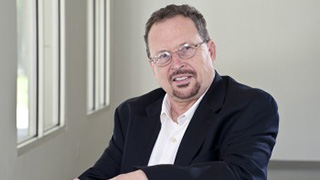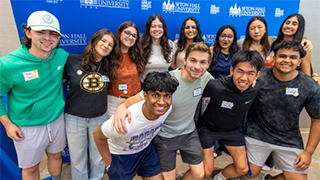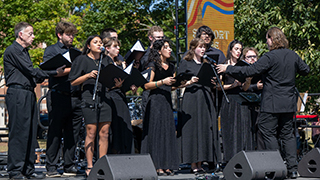Living in a Material World: Sergiu Gorun’s Grant-Supported Innovative Chemistry
Tuesday, November 7, 2023
Professor Sergiu Gorun, Department of Chemistry & Biochemistry
Gorun was motivated primarily by the desire to protect people and the environment from harm using the study of "material chemistry", developing materials that helped protect people. "I started this type of thinking and work about 15 years ago at different universities, and it got the attention of the Department of Defense," Gorun says. Their premium is scholarly and high-quality work. He received support from the National Science Foundation, the United States Army, and the Air Force. His current research seeks to create a material that will use only sun and air, not chemicals, to produce activated oxygen. "There is a component of medicinal chemistry that’s running here as a minor component, aimed at photodynamic therapy and curing cancer."

Professor Alexander Fadeev, Department of Chemistry & Biochemistry
Gorun collaborates with Alexander Fadeev, Ph.D. and James Hanson, Ph.D., both Professors of Chemistry here at Seton Hall. They currently work with the Defense Threat Reduction Agency (DTRA), a US governmental organization that efforts biological and chemical reduction of threats, including weapons of mass destruction. The DTRA award was then among the largest awarded to Seton Hall for research purposes. In this case, the threats are not nuclear, but chemical. "They are extraordinarily toxic, and unfortunately are more available than a nuclear bomb" he says. There are several uses for these kinds of materials during wars. "Let’s say someone throws toxic chemicals at you. What you tend to say is that you want to take an antidote, but you cannot protect yourself all the time, like if you work in a subway or on a bus." If such an attack occurs, "antidotes are OK, but if you’re too late, you’re too late."

Professor James Hanson, Department of Chemistry & Biochemistry
Gorun works on materials that can be worn or painted on a wall and used to protect both civilians and government officials. "These materials will generate a continuously activated form of oxygen and react to light. There is a lot of oxygen in the blood, so the idea came from cancer research," he said. The research revealed that these materials will work to protect people from biowarfare even without sunlight, or outside oxygen. Any light and any air will activate them. "In our lab, we are using a cheap Polaroid slide projector as a source of artificial light. As long as there is oxygen available, it will work."
Gorun works on materials that are highly sensitive and dangerous. "In our laboratory, we deal with simulant chemicals, but we cannot use the real thing, because it’s too toxic," he said. "For the real [chemical], we work with another institution in Texas that is authorized by the Department of Defense. We come up with our materials, test them on the so-called models, and do a lot of research to identify the best one. Then, the best one goes to them to test against the real thing."
Some of his research also addresses the ability to detect levels of antibiotics in the environment. He recently published a paper in which he and his team destroyed antibiotic-resistant "bugs", and he cites discarded antibiotics in the water supply as partially responsible for weakening humans’ resistance to illness. This new paradigm of analytical chemistry, which he said could detect infinitesimal amounts of antibiotic presence, was published in the highly regarded journal, Nature.
José Lopez, Ph.D., Professor of Physics and Director of the Office of Grants and Research said "We want to make sure his work gets noted. The university is very supportive of his work."
Seton Hall is a Carnegie R2 university, attracting funding from the federal government and the private sector. The goal is to grow grants and research. "One of the things we’ve come to realize as a university is that our mission is to affect the world in many ways, and part of this is to educate our students in a modern context," said Lopez. "Being active in research, ranging from the sciences, the humanities, diplomacy and law, is vital. Our current and future faculty, we want them to help change the world."
Gorun agrees that Seton Hall has the capacity to grow in grants and research. He expects his students to do the same, and it’s clear when you visit his lab that he cares deeply about their success. His students and collaborators are like family, he says. "My students… know that they are going to be helped and pushed."
Categories: Research, Science and Technology






